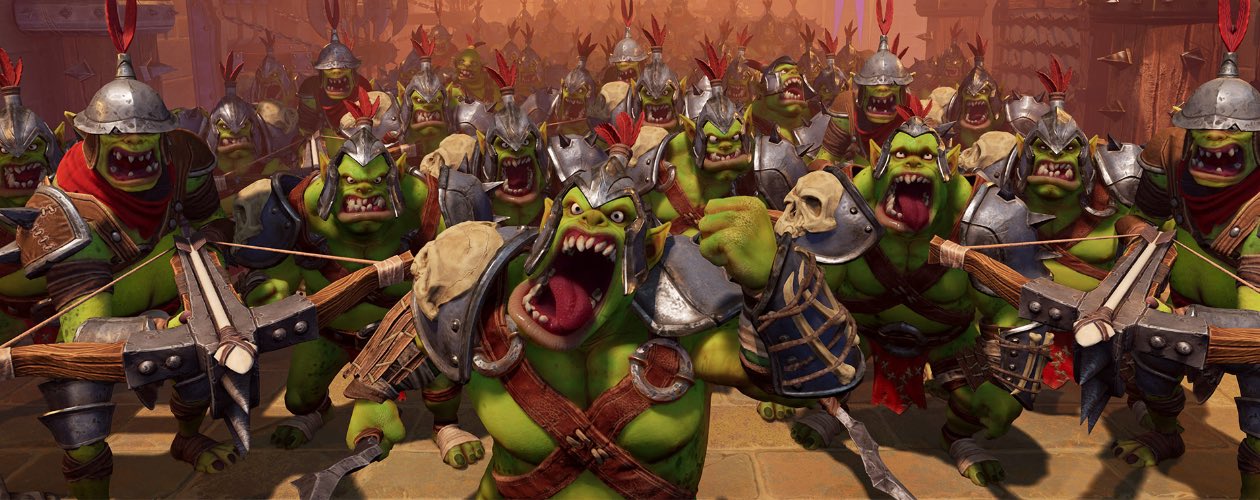It’s an inspiring thing to see a game wear its heart on its virtual sleeve. Compared to each wildly different Final Fantasy game, Orcs Must Die! 3’s title provides all the information you could ever need to know about its gameplay, setting, how many games there are, and probably the narrative too. There’s Orcs, and it’s up to you to send them back to their Orc-y maker.
Just as with the previous entries, that’s plenty of fun to be had smushing hundreds, and even thousands of verdant villains, though this game brings even larger scale battles than before. It’s just a shame they don’t advance the series in quite the way you might have hoped.
Orcs Must Die! 3 is a tower defence game. Like its predecessors your main focus is stopping Orcs from making it to your rift; a glowing portal that they’re indelibly drawn to like green moths to a welcoming flame. In order to repel the waves of attackers, you place various traps of differing lethality in their way, aiming for a layout that’s going to result in the most death to Orc-kind.
It is, like Dungeon Defenders, very much a tower defence game that relies on action gameplay to shore up shortcomings of you traps. Orcs Must Die! 3 is happy to oblige in that regard, giving you the tools to run around attempting to finish off the stragglers, with an array of different weapons to unlock to keep things fresh throughout the central campaign.
The number of different traps you can unlock is frankly unbelievable. Starting with the classic metal spike trap, things just get increasingly more lethal and outlandish, with lava pits and spring-mounted launchers giving way to crazy trees that produce sap to confuse the already simple Orcs.
It’s one of Orcs Must Die! 3’s greatest strengths that they’ve given players such a wide choice of tools, and it allows for different tactics each and every time you play. You’re also not trapped into simply sticking with the same traps that you’ve already upgraded, as you can opt to refund all of your previously spent upgrade points and dole them back out to the latest weapons in your arsenal, ensuring you’re never stuck.

War Scenarios are where Robot Entertainment have opted for the tried and tested sequel formula of simply making everything bigger. Unfortunately, that hasn’t made everything better. Instead of keeping you in the close confines of a castle interior, War Scenarios sees you take the battle outside, adding larger, external areas to defend before the Orc hordes pour into your castle with reckless abandon.
There are new and unique traps called War Machines specific to these larger battles, and they’re designed to cause as much mayhem and destruction as possible. Just as with the other missions, you have chance to set things up beforehand, and then have the enemy unleashed when you’re ready. The first time you see a veritable swarm of Orcs coming towards you is a humbling experience – it’s a real Helms Deep moment – but then the reality becomes apparent.
The Ballista – the most effective large-scale long-range weapon – needs you to hop in and take direct control of it. You’ll dutifully do that, but you soon find that that it mainly boils down to finding the right spot and spamming the right trigger as you launch as many explosive barrels as possible at the same location in an effort to thin out the Orcs’ advancing line. It’s simply not that engaging.
Once you add in the fact that the large-scale map is actually pretty wearying to run about in, especially as a solo player, and that there aren’t enough funds available to craft extensive route-changing blockades – one of the most fun things in tower defence games – it all feels like a bit of a missed opportunity. These should have just been wild opportunities to use hundreds of traps at once, but that never really materialises. War Scenarios do feel much better in co-op, with the scale making more sense with another player in tow, but they’re still not the ultimate expression of the series’ strengths.

It’s disheartening when the game looks as good as it does during these scenarios. The various Orcs are tremendously well constructed and animated, and the huge number of different trap types are visually appealing and distinctive, while the larger scale really shows off the team’s abilities with Unreal Engine 4. It all runs like a dream too, even when there’s more Orcs than you can count.
There’s eighteen campaign scenarios, each with multiple waves of enemies. That might not seem like a huge number, but the standard difficulty provides more than enough challenge that you’ll likely have to try a few different tactics before getting through each level. There’s plenty of incentive to return as well, not just in the copious number of traps to try out, or the online leaderboards where you can see where you stack up against both your friends and the best players online, but in the returning Endless mode that lets you try to survive for as long as humanly (Orcishly?) possible.
There is a narrative here too, and every time it comes into play you’ll be impressed by both the quality of the cutscenes, and the voice acting. That said, there simply isn’t enough made of it. It would have been fantastic to explore the lore in greater depth and experience a more fully-realised storytelling experience, but this game is not that.




